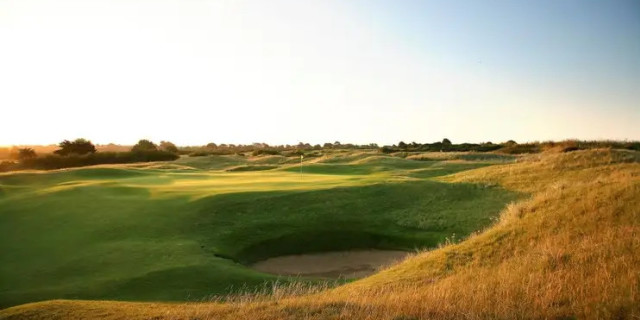
Carnoustie Championship Course Guide and Review
Host of the 2018 Open Championship, Carnoustie Golf Links has long established its own uniquely developed and earned reputation within the game. Consisting of three courses – the Championship, Burnside, and Buddon – it’s a striking public facility that is used by several local clubs and greatly supports the community of this small, unassuming Angus town, just several miles along the coast from the bustling university city of Dundee.
Like nearby St Andrews Links – which you can see distantly across the water on a clear day – Carnoustie represents the foundations of golf at its best. And it truly is among the good.
Though the Burnside and Buddon are two excellent and well-conditioned layouts that share the same links land, it’s the Championship Course that understandably draws most attention when it comes to visitors, a majority of whom have come internationally. What attracts them is the prestige and challenge of this brilliant design, which both matches and subverts expectations.

History
Its pedigree within the history of the game’s oldest and greatest championship dates to 1931, when the revered Scots-American golfer Tommy Armour lifted the Claret Jug. Henry Cotton won several years later, but in 1953 – perhaps the most famous of Carnoustie Opens – the legendary Ben Hogan made his solitary appearance in the event, and memorably secured victory and indelibly wrote himself into local folklore. The par five 6th hole, ‘Hogan’s Alley’, is a monument to that success.
Gary Player won his second Open in 1968, seven years before the greatest champion of the modern era, Tom Watson, overcame Australia’s Jack Newton in a playoff to begin his extraordinary story in the Championship. Drawing the 20th century of Opens to a close, the 1999 edition was quite a spectacle, with difficult conditions tipping the setup of the course over the line, but there was no questioning the drama, as Jean van de Velde failed to capitalise on a three-shot lead on the 72nd hole, finishing in a playoff with former winner Justin Leonard, and Scot Paul Lawrie, who had recorded a brilliant 67 on the Sunday to move into contention.
The man from Deeside – just a short drive from Carnoustie – was inspired as he delighted the home crowd to complete a triumph that arguably remains underrated. Returning in 2007, the Championship that year was also packed with drama, as Padraig Harrington overcame Sergio Garcia in a playoff, following a thrilling and unpredictable back-nine. Most recently, Francesco Molinari mastered a firm and fast Carnoustie, overcoming a leaderboard that included Rory McIlroy, Justin Rose, Tiger Woods and Jordan Spieth. The Women’s British Open and Senior Open Championship have also graved the venue.

However, the memories of these past championships – particularly 1999 – saw Carnoustie being defined by its perceived difficulty. ‘Car-nasty’ was a name coined that stuck more than it deserved to. It was framed as the tough course on the Open rota. But that somewhat narrow description betrayed the reality of the Championship Course, which merits more varied superlatives to express just how wonderful an experience it is to play, something that was displayed throughout the 2018 Open. We saw Carnoustie at its best.
Yes, it stands as a resolutely challenging layout and boasts a fearsome closing sequence of holes, but crucially never is the course gimmicky or unfaithful. Carnoustie is a test for golfers of all standards, but it is a fair one. This is one of the truly great courses, and it’s now recognised as such.
The Experience
Easily accessible by car or train – the railway line runs alongside the edge of the links – the welcome to Carnoustie lays the foundation for the day to come. The Hotel is a striking landmark that is a visual reference point throughout the round, but a recent addition is the spectacular new clubhouse – the Links House – that has been created to complete the experience of Carnoustie.

Boasting the well-stocked pro shop – led by Head Professional Colin Sinclair – and standard facilities for golfers, the second floor is home to The Rookery; a superb restaurant that features panoramic views across the expanse of the Carnoustie Golf Links. It’s a wonderful spot for a post-round drink or meal.
More notably, however, is the addition of seven high-tech simulators, which have been introduced to aid the tuition work of the professionals, but also to help introduce the game to local school children, who can use the facilities for free. What did we say about Carnoustie representing what is truly great about the game? This is a modern encapsulation that.
To quote Golf Services Manager, Colin McLeod, “we wanted a five-star experience to match our five-star course.” They have certainly accomplished that. Carnoustie has reached new heights.

The Course



Tom Watson played the 16th five times on route to winning the 1975 Open - including once in the playoff - and made bogey on each occasion. This lengthy par three is protected by bunkers on either side of a narrow entrance to the green, which is long but sits like an upturned saucer. Visitors to Royal Dornoch will understand. Only the best shot will do, and a par made here will feel like a birdie.
Dependent on the conditions, this can play as the most difficult hole in championship golf. It's a thrill to play. Out of bounds is a danger throughout - particularly with approaches to the green as it sits remarkably close - and the Barry Burn roams around the fairway and short. We have seen greatness and tragedy on this incredible par four, but like the Road Hole at St Andrews, you will always remember what you made on the Home Hole at Carnoustie.
Conclusion

About the author

Kieran Clark is the Digital Editor of Golfshake. He oversees editorial content, community engagement, forums, and social media channels. A lifelong golfer from the Isle of Bute in Scotland who has now lived in St Andrews for a decade, he began playing at the age of five and maintains a passion for exploring courses, with a particular affection for historic layouts. Kieran regularly contributes in-depth opinion pieces and features, drawing on his enthusiasm for the game and its culture.
Related Content: The Open Carnoustie





